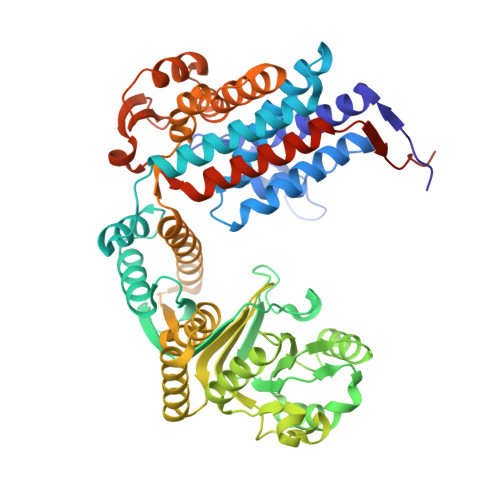Bis-sulfonamido-2-phenylbenzoxazoles Validate the GroES/EL Chaperone System as a Viable Antibiotic Target.
Godek, J., Sivinski, J., Watson, E.R., Lebario, F., Xu, W., Stevens, M., Zerio, C.J., Ambrose, A.J., Zhu, X., Trindl, C.A., Zhang, D.D., Johnson, S.M., Lander, G.C., Chapman, E.(2024) J Am Chem Soc 146: 20845-20856
- PubMed: 39041457
- DOI: https://doi.org/10.1021/jacs.4c05057
- Primary Citation of Related Structures:
9C0B, 9C0C, 9C0D - PubMed Abstract:
We recently reported on small-molecule inhibitors of the GroES/GroEL chaperone system as potential antibiotics against Escherichia coli and the ESKAPE pathogens but were unable to establish GroES/GroEL as the cellular target, leading to cell death. In this study, using two of our most potent bis -sulfonamido-2-phenylbenzoxazoles (PBZs), we established the binding site of the PBZ molecules using cryo-EM and found that GroEL was the cellular target responsible for the mode of action. Cryo-EM revealed that PBZ1587 binds at the GroEL ring-ring interface (RRI). A cellular reporter assay confirmed that PBZ1587 engaged GroEL in cells, but cellular rescue experiments showed potential off-target effects. This prompted us to explore a closely related analogue, PBZ1038, which is also bound to the RRI. Biochemical characterization showed potent inhibition of Gram-negative chaperonins but much lower potency of chaperonin from a Gram-positive organism, Enterococcus faecium . A cellular reporter assay showed that PBZ1038 also engaged GroEL in cells and that the cytotoxic phenotype could be rescued by a chromosomal copy of E. faecium GroEL/GroES or by expressing a recalcitrant RRI mutant. These data argue that PBZ1038's antimicrobial action is exerted through inhibition of GroES/GroEL, validating this chaperone system as an antibiotic target.
- College of Medicine, Department of Pharmacology and Therapeutics, Center for Inflammation Science and Systems Medicine, The Herbert Wertheim UF Scripps Institute for Biomedical Innovation and Technology, University of Florida, 130 Scripps Way, Jupiter, Florida 33458, United States.
Organizational Affiliation:
















